Versatile, adaptive, and helps to remove excess nutrients, hornwort is an excellent option for both seasoned and new aquarists.
But it’s not always fun and games when it comes to this plant.
In this guide, I’ll discuss with you the pros and cons, how to choose healthy hornwort, and how to keep it healthy and thriving.
By the end of this guide, you’ll know if this plant is right for you.
Table of Contents
Classification & Quick Care Stats
- Scientific Name: Ceratophyllum demersum
- Family: Ceratophyllaceae
- Kingdom: Plantae
- Order: Ceratophyllales
- Clade: Embryophytes
- Care Level: easy
- Growth Rate: fast
- Tank Placement: background
- Lighting Requirement: medium
- Ideal Temperature: 60°-80°F (15°-26.7°C)
- pH: 7.0-8.0
- Water Hardness: 5-18 dGH (83-300 ppm)
Hornwort Plant Overview
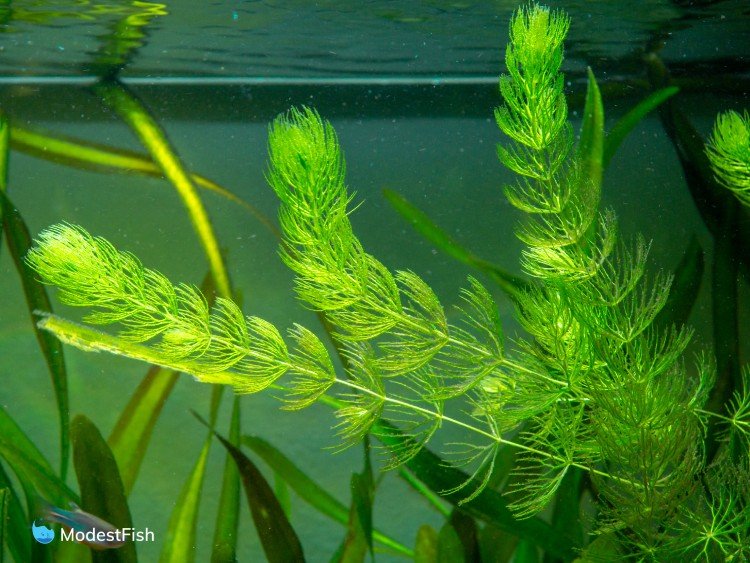
Hornwort, Ceratophyllum demersum, is a freshwater plant found in ponds, lakes and slow-moving streams. It is truly prolific with cosmopolitan distribution, meaning it’s found on every continent except Antarctica.
It is mostly a floating plant, but it may also loosely attach itself to the substrate. It grows in huge bunches in areas of low current, with individual strands that can grow as much as 15 feet (4.5 meters) long.
The plant grows long, slim stems that are about a 1 millimeter wide. Needle-like leaves grow in whorls along the length of the stem, with short gaps in between each whorl. Side shoots fork off of the main stem, making a single plant look like a giant matt made up of multiple plants.
The whorls of needles make the plant resemble a bottlebrush, or a raccoon’s tail, which accounts for its other common names, foxtail and coontail. The needles are stiff and serrated, making the plant unpalatable to most fish.
Depending on nutrient and light levels, it may be a light olive to dark shamrock green.
Hornwort does not grow roots. It absorbs nutrients directly from the water column through its stems and leaves.
In the wild, it’s an important habitat feature where small fish and fry can hide from predators.
Water Conditions For Hornwort
Hornwort is very adaptable, so much so, that it can be found in waterways all over the world.
It can easily handle the lower temperatures of unheated shrimp tanks all the way up to the tropical tanks that run in the 70s and 80s.
It’s also not terribly picky when it comes to water hardness, thriving in hard water tanks just as well as it does in neutral water.
Lighting Conditions
Hornwort needs medium to high lighting in order to thrive. It may be able to survive in low light but it may not grow at all, or worse, it may turn brown and die.
Even if it can survive and grow a little bit under lower light, the plant will not be as attractive. The growth will become leggy, meaning that the gap on the stem in between each whorl of needles will get longer. This makes the plant lose its bushy appearance and look more sparse.
So, if your tank doesn’t have strong lighting, maybe consider going with a plant that is more tolerant of low-light conditions, like moneywort.
How to Plant Hornwort In Aquarium
Hornwort is pretty darn versatile. You can leave it to float at the top of the tank, weight it down with driftwood, rocks or other decor or even partially bury it in the substrate.
Floating
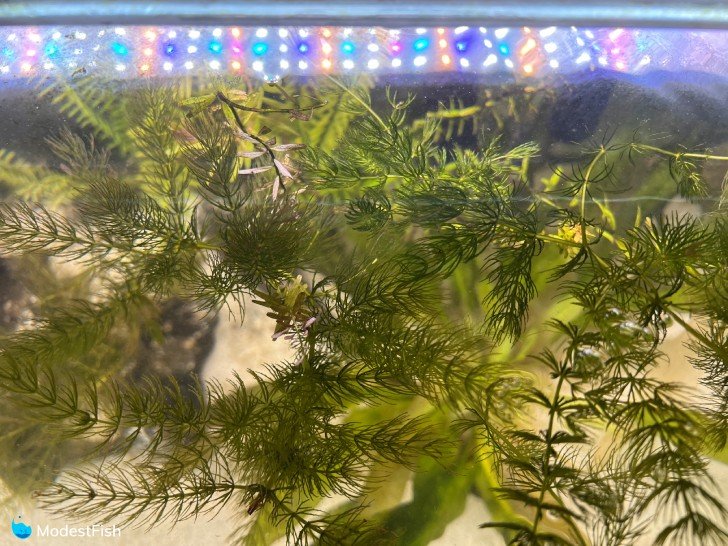
If you want to leave your hornwort floating, but don’t want it traveling all over the tank, you can place a strong suction cup on your aquarium glass.
Cut a small section of airline hosing and run fishing line through it. Make it just long enough to go around your hornwort. Wrap the airline hose and fishing line around the bunch of hornwort and then tie the fishing line to the suction cup.
This will anchor the hornwort in place and the airline tubing will keep the fishing line from cutting through the delicate stems of the plant over time.
Weighted Down
If you have some good sized rocks or driftwood, you can stick one end of your hornwort underneath it and place the decor on the substrate.
Buried in Substrate
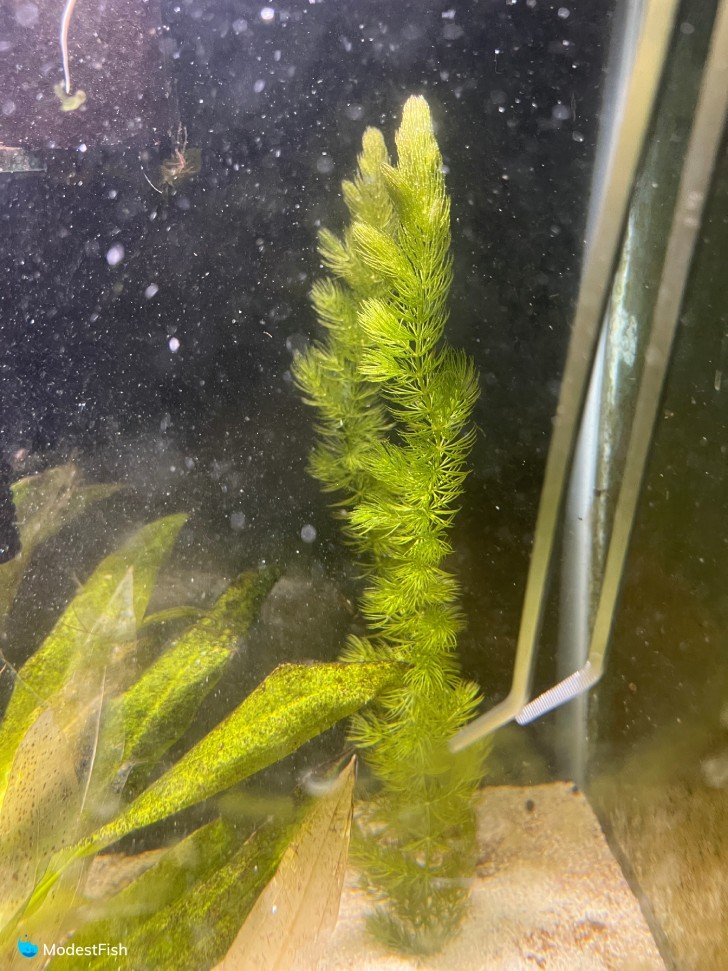
You can also just pile a bit of gravel on top of one end of your hornwort to weigh it down. The end that is buried may lose its needles and branches.
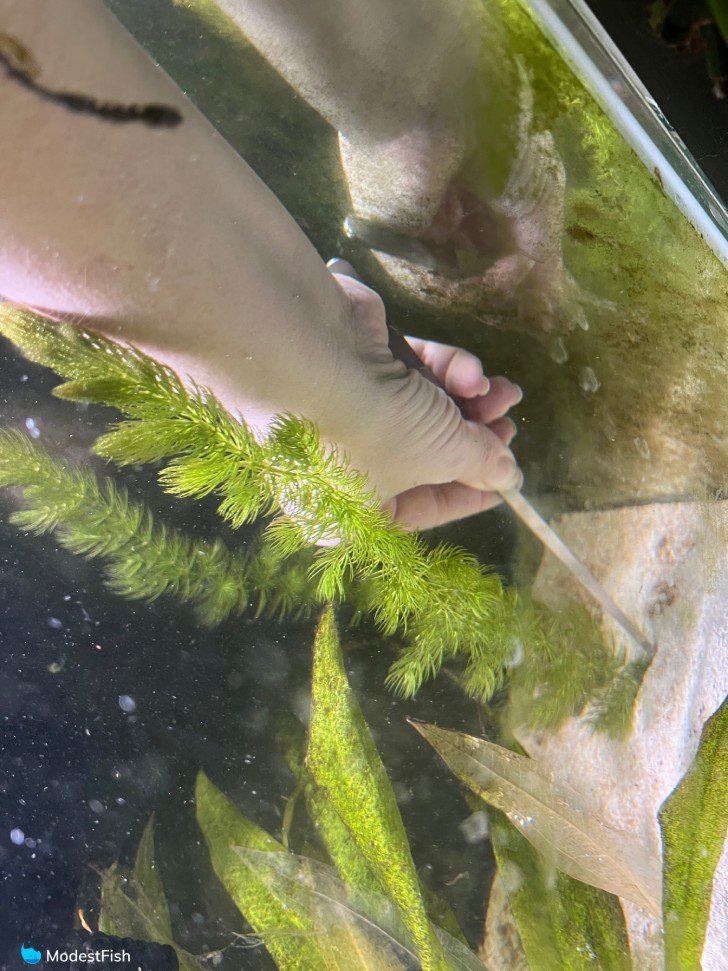
Your plant might start to grow small root-like structures called rhizoids that will help to anchor it down to the substrate. These hairlike rhizoids might resemble roots, but they don’t suck up nutrients, they only function to hold the plant in place.
Maintenance For Hornwort
Once established, hornwort is an easy keeper that shouldn’t be much trouble.
The biggest hassle isn’t trying to keep this plant alive, it’s trying to keep it from taking over your entire aquarium.
Since it tends to grow like crazy, you’ll probably need to trim it back once or twice a month to keep it from spreading everywhere.
You can just discard the trimmings in the trash, or you can keep them in the tank and they will grow into a new plant.
Substrate & Fertilizer
Hornwort absorbes it’s nutrients directly from the water column so there is no need for an aqua soil. Any kind of substrate will do.
Hornwort doesn’t require you to run CO2. But, just like other plants, it will grow even faster if you do run CO2 in the tank.
One thing that you may need to keep up with is dosing the tank with liquid fertilizers. Hornwort eats up nutrients very quickly. This is great if you need it to outcompete algae in the tank, but it’s not so great if the hornwort eats everything up before your other plants can get what they need.
Keep on the lookout for signs of nutrient deficiencies in your plants and start dosing liquid fertilizers as needed.
Although it is really easy to take care of, you will still have to deal with cleaning up dropped needles when you do your water changes. This will get better once the plant has acclimated to your tank, but it never stops completely.
Propagating Hornwort
Propagating this plant couldn’t be simpler. Just cut off a piece of stem and it will grow into a new plant.
You can cut off a piece that’s a few inches long and bury half in the gravel or weigh it down with decor. You’ll quickly start to see it add on new growth.
How Hornwort is Used in Aquariums
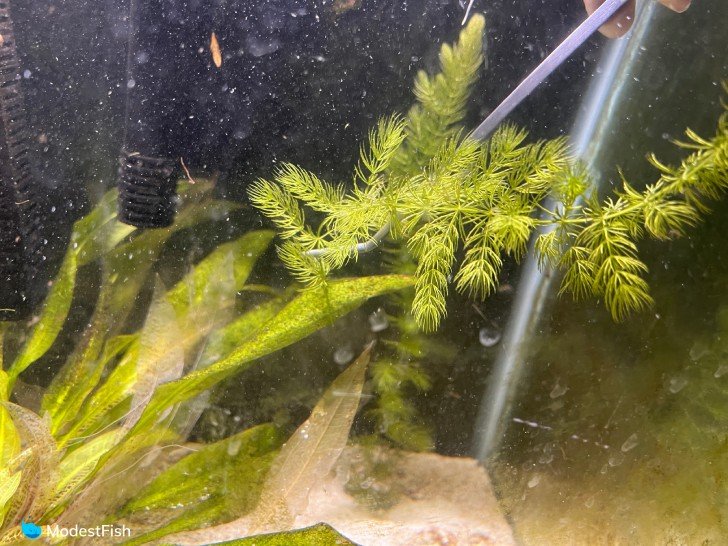
Hornwort is primarily used as a decorative plant in aquariums. It can be weighed down with decor or plant anchors, allowed to float free in the water column or planted into the substrate.
It is particularly popular for fish breeding tanks as well as ornamental shrimp tanks.
Hornwort can also be planted inside the main display tank, or in a filter or refugium so that it will take up excess nutrients in the water column.
Benefits of Hornwort
Here are some cool benefits of having hornwort in your aquarium
Removes Excess Nutrients
Fish and invertebrates in your tank put off wastes. As waste breaks down, it puts off nitrate (NO3-) and phosphate (PO4). And this is exactly the stuff that algae loves to eat.
Hornwort grows fast, really fast. In order to do that, it needs fuel, which it gets by eating up the nitrate and phosphate in your water.
Which is awesome.
Reducing nitrate can help improve your water quality and overall fish health since excess nitrates can start to stress fish and make them more vulnerable to disease. Nitrate is also acidic and drops your pH over time.
You’ll still need to do weekly water changes, but hornwort can help keep your water cleaner in between.
Shrimp Love It
Ornamental shrimp spend all day grazing along surfaces to find any algae, uneaten food and biofilm lying around. Adding plants to your shrimp tank is always a good idea since it increases the surface area that shrimp have to feed on.
Shrimp will love to hang out in bunches of hornwort, feeding on the biofilm that grows on it.
Hornwort also makes a great hiding place for tiny baby shrimp that need to avoid hungry fish until they can put on enough size to avoid being a snack.
Cover for Fry
Just like baby shrimp, baby fish also love to hide in hornwort.
That giant bushy mass of stems and needles provides, not only an excellent hiding place that can protect fry from adult fish, but also a source of food. The biofilm that grows all over it is an excellent food source for growing fish.
That way, tiny fry don’t have to venture out of the protection of the hornwort to find something to eat.
Helps Control Algae
I think this is a pretty neat property, hornwort helps control algae in two different ways.
First, it eats up nitrate and phosphate so fast that it reduces what is left for algae to use. This may help you to control green algae, like green dust and hair algae.
Second, it secretes substances that help to beat back blue-green algae (cyanobacteria).
Unfortunately, these substances don’t affect green algae, but helping to prevent blue-green algae in a low flow tank is invaluable.
Tolerates Hard Water
Some more delicate species of plants will not grow well if you have hard water.
But hornwort is so tough, it really couldn’t care less.
Fish Don’t Like to Eat It
This might seem like a weird benefit, but if you’ve ever tried to grow live plants with species of fish that are notorious for tearing up live plants, like cichlids, then you know that this attribute is like solid gold.
OK maybe that’s an exaggeration, but it’s pretty cool to have a plant that these fish won’t destroy.
The needles are tough and really pointy, so the texture doesn’t really appeal to most fish.
It’s even been tested with African cichlids, whom I have personally seen rip through some of the toughest plants in a manner of hours, and they left hornwort alone while they happily destroyed other species.
Downsides of Hornwort
As awesome as hornwort is for helping with water parameters and providing shelter for fry, it does have a few downsides.
It’s Messy
Hornwort sheds like crazy, so you’ll have to do some routine clean up in order to maintain your tank. I think the best analogy that I’ve seen compared hornwort to an old Christmas tree. Its needles break off all the time and sink to the bottom of the tank.
Needle shedding can be especially terrible when you first add this plant to your tank because it is adjusting to the water conditions in your aquarium.
After you get done cussing about the mess, you may start to fear that the plant is dead. But you should leave the stems in place for a few weeks and the needles will probably start to grow in again.
If you handle the plant at all, branches and little pieces will break off constantly and go all over the tank.
And any little piece that you miss can potentially start a whole new plant. So you might end up with a piece of hornwort growing out of another plant or on your filter intake.
Be prepared to do some housekeeping if you add this species to your tank.
Not Great for Aquascaping
If you want a neat and orderly aquascape, this is not the species for you. Hornwort grows like mad and tends to put out new branches that spread all over the tank.
This makes it great for jungle tanks, but if you’re looking to do something like an Iwagumi tank or Dutch aquascape, this is probably not the plant for you.
I think you’d have to trim it almost daily to keep it under control. And it would shed messy needles all over the place. Not a great look for a fancy aquascape.
How to Choose Healthy Hornwort for Your Tank
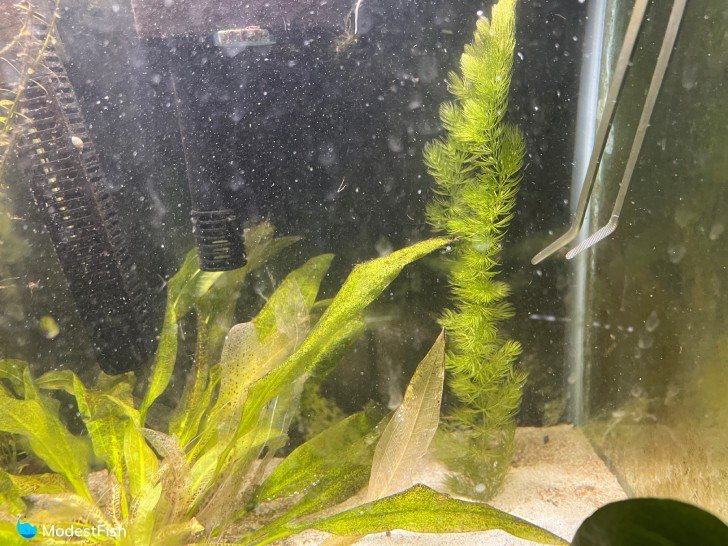
Healthy hornwort should be really bushy, with stems covered thickly in needles. It should look like bright bottlebrush on steroids.
So don’t buy hornwort that has only a few sparse needles every few inches. That shows the plant is already under stress.
The needles should be a fairly uniform green, with just the tips of each branch being a little bit lighter near the growing point.
So, avoid hornwort that looks brown in big patches. It’s stressed and not doing well.
Is Hornwort Right For You?
Hornwort is a versatile plant that has adapted itself to live in waterways all over the world.
This species provides a lot of benefits, like helping to remove excess nutrients and providing food and shelter for shrimp and fry.
It can, however, have some downsides. The single biggest complaint is that it can shed its needles and make a big mess, especially as it acclimates to a new tank.
Hornwort is easy to plant since it doesn’t have to be rooted in place. You can bury part of it in the substrate, weight it down with decor or just simply let it float.
It’s also simple to propagate this plant, all you have to do is make some cuttings and you’ve got yourself a whole new plant.
Overall, it’s a great plant for beginners since it grows quickly and doesn’t require fertilizers or CO2.
